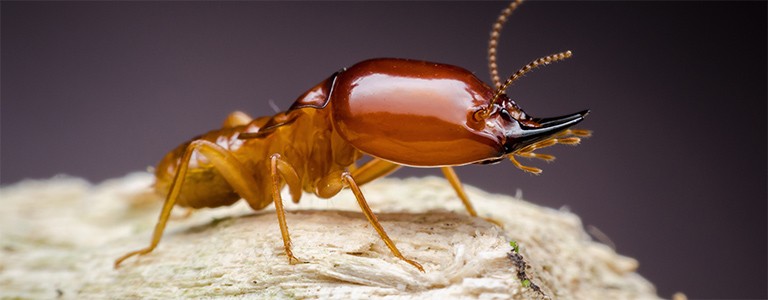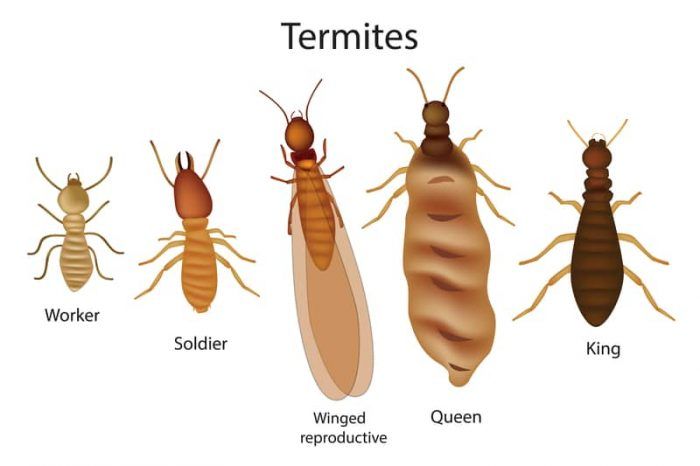Learn More
Termites (White Ants): When was the last time you had your home inspected?
Many of us know very little about termites, but it’s important to “know your enemy“!
Hopefully this information will help you pick up the signs of early termite activity and give you an understanding of the common termites and the challenges pest professionals face in controlling these species.
After all, you need to protect one of your biggest assets: your home!
Termites are a highly destructive timber pest causing major structural damage to buildings.
One in four of unprotected properties in Australia will be attacked by termites during the life of the building.
Severe structural timber damage to homes is on the increase due to more homes being built of materials and designs that encourage hidden termite entry and infestation.
Termites are known to destroy most of the wall and roof framing structural timbers of a home within 3 months of construction.
Termites are estimated to cause more structural timber damage to homes than from fire, floods and storms combined.
Also, house insurance DOES NOT cover the repair costs of damage caused by termite’s infestations in your home.
Termites often build above ground nests, where moisture collects in the wall cavity, e.g. from leaking pipes, shower recess or faulty guttering etc.
Subterranean termites a.k.a. “white-ants” build a central colony nest from which they construct underground tunnels that radiate through the soil in about a 100 metre radius in search of cellulose timber food sources… maybe your home.
Termites are highly secretive insects preferring to enter a building through areas inaccessible to inspection, such as, through in-fill patios, fire heaths, expansion joints and cracks in concrete slab (on-ground) flooring.
Termites can pass through a 2mm crack or expansion joint eating through rubber compound between adjoining concrete flooring. They often travel under parquetry and floor tiles to get to the wall framing timbers.
Termites need to maintain a high level of humidity and temperature (25 to 35c) in their central colony nest. They eat through the center of susceptible timbers leaving nothing but a thin veneer of timber and paint. They will pack mud in cracks and joints in timber to prevent loss of humidity and resultant dehydration.

Termite Control Options
A home owner who finds signs of termite activity inside their home have several options for professional protection from continued termite infestation and timber damage.
A thorough inspection of the home and surrounds includes a detailed written report to Australian Standard 3660 re areas inspected, evidence found of termite activity, identify high risk termite entry areas inaccessible to inspection, apply termite control options and limitations.
Chemical Soil Treatment around the perimeter and sub-floor of a building to eradicate termites attempting to gain entry into the building. Termidor or Premise Termiticides are recommended.
Termite baiting is an installation monitoring of termite bait stations. This method relies heavily on the termites finding and consuming sufficient bait recommended in some limited circumstances particularly in areas where live termites activity is present.
Building Modification and Maintenance termite risk reduction measures may include improving sub-floor ventilation removal of timber in contact with the soil anddeveloping inspection access areas.
Subsequent Inspections to Australian Standard 3660 is essential at 3 to 6 months intervals where signs of termite activity has been previously located close by susceptible buildings or timber structures.
Termite Inspection Report Australian Standard 3660
First step is toobtain a professional termite Inspection Report, a thorough inspection of the building and surrounds. It is a written inspection report and detailed specifications to A.S.3660 for an integrated termite control program. It is recommended the inspection and report be received and considered in detail before any protective measures are commenced.
The inspection includes all accessible timbers within the crawl space in the sub floor roof void interior exterior area, garden landscaping fences, and other timber structure trees in the locality.
The Fascinating Biology of Australian Termites

White-ants are not ants at all. They are ground dwelling timber eating insects originating from prehistoric cockroaches. The oldest termite ever found was in Arizona preserved in amber fluid and dated at 220 million years old!
Independent caste system within a termite nest
There are members of different castes, each with a different and interdependent role to perform including the queen, king, the winged swarmer or reproductive (young king and queen), soldiers and workers.
The queen following her hazardous flight and after mating becomes an egg laying machine; her body becomes hugely enlarged she can live more than 25 years producing more than 2,000 eggs a day.
The king and queen live in a central chamber and are tended by the workers.
Worker termites are by far the largest cast in the colony and the one that does the damage: they are a creamy translucent colour, soft bodied organism. They carry out all work in the nest, including gathering food ( timber and other cellulose); constructing tunnels; repairing and enlarging the termites colony nest; grooming each other and feeding the soldiers, the king, queen and also caring for the young nymphs until mature. They are 3 to 4 mm long, have no wings, are sterile and blind; work 24 hours a day for several years life span in some species.
Soldier termites commonly have an orange coloured and armoured head. Their jaw pinchers which they use to crush an attacker such as ants; some have hard pointed snout which eject a white sticky latex to catch their enemies. The soldiers are usually the first to be seen in large numbers by the home owner when the termite workings ( shelter tubes or damaged timber) are opened and the soldiers rush out to guard the opening whilst the workers repair the damage.
Swarmers are commonly seen when they swarm on a hot humid evening around dusk they have eyes and are poor fliers but are swept along by the wind – they land, drop their wings, find a mate to become king and queen of a new colony. The swarmers are emitted in their thousands when a mature termite nest is large and well established.
By Sonya Boyd